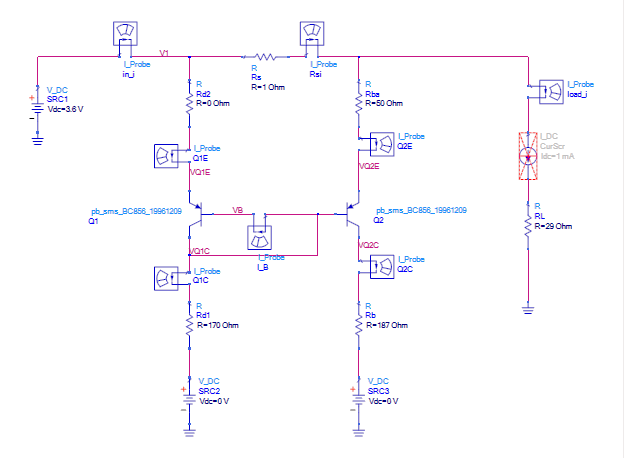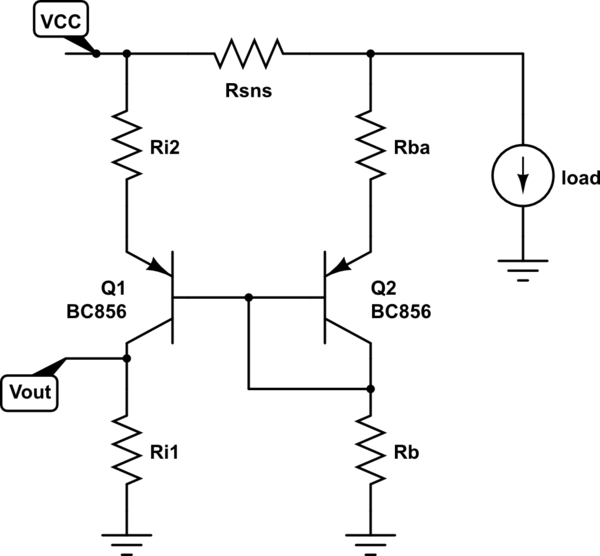I'm going to stick with the discrete BJT design you found. It's not bad, despite comments and pointers, otherwise. But it is missing a few details. And I'm going to keep it a single-supply design. No negative rails here.
Before I launch into it, this is actually a complicated product-log problem (as are pretty much all BJT kind of problems, due to the Shockley equation behavior.) So there is a place where I will skate across some details that are kind of important, quantitatively. But I'm doing that because I don't want to dig into the closed mathematical expression, as it involves a function you've probably never heard of (Lambert's W.) So grant me some room there.
Let's pony up a schematic to talk about:

simulate this circuit – Schematic created using CircuitLab
Everything happens in an order of magnitude. Good rule of thumb to keep in mind. Either everything happens \$\pm\$ an order of magnitude around a center or else it's just one order.
- Assume a maximum load current of \$I_{_\text{MAX}}=50\:\text{mA}\$.
- Assume \$V_{_\text{CC}}=5\:\text{V}\$.
In general, you have to pick a maximum voltage drop for \$R_{_\text{S}}\$ at the worst-case load current. I think a value of \$100\:\text{mV}\$ is usually acceptable. So let's go with that. This means \$R_{_\text{S}}=2\:\Omega\$.
Using the above rule of thumb, we don't want to go less than about \$\frac1{10}\$th of that. So this means that the minimum current through \$R_{_\text{S}}\$ should be about \$5\:\text{mA}\$. That's going to set \$Q_2\$'s quiescent current for us. So when there is no load current at all, that's the emitter/collector current for \$Q_2\$. This means the quiescent (no load) voltage drop across \$R_{_\text{S}}\$ should be \$10\:\text{mV}\$ -- that is consistent with our 'order of magnitude' rule.
We want to trade off voltage across \$R_{_\text{A}}\$ as the voltage drop across \$R_{_\text{S}}\$ changes. So as the drop across \$R_{_\text{S}}\$ goes from \$10\:\text{mV}\$ up to \$100\:\text{mV}\$, the same thing should approximately happen across \$R_{_\text{S}}\$, but in reverse. The problem here is that the BJT (\$Q_2\$) won't cooperate with us. As the current in \$R_{_\text{A}}\$ declines, the \$V_{_\text{BE}}\$ for \$Q_2\$ will adjust itself to oppose that change. There will be about \$60\:\text{mV}\$ change in \$V_{_\text{BE}}\$ for a factor of 10 change in the current (which is what we are targeting due to the rule.) So here is where that Lambert W thing gets in the way. I can just finesse across this and tell you that instead of going from about \$100\:\text{mV}\$ across \$R_{_\text{A}}\$ down to \$10\:\text{mV}\$, it will instead be more like \$100\:\text{mV}\$ across \$R_{_\text{A}}\$ down to \$50\:\text{mV}\$ -- due to the Shockley equation interfering. That's a factor of 5 more than the expected minimum. But this is okay. It just has to be recognized and accepted, is all.
To get a quiescent \$100\:\text{mV}\$ across \$R_{_\text{A}}\$, at \$5\:\text{mA}\$, \$R_{_\text{A}}=20\:\Omega\$. So that's now set in stone, too.
We also now want the sum, \$10\:\text{mV}\$ plus \$100\:\text{mV}\$, across \$R_{_\text{C}}\$. So it is time to consider the left side of the schematic for a moment.
The left side is just two resistors and a diode drop. So very easy to calculate. We should make it semi-stiff, because the base voltage of \$Q_1\$ sets the base voltage for \$Q_2\$. So let's double the quiescent current. (Or more.) Because the sum is \$110\:\text{mV}\$ on the right side, we would like to divide by 11 to keep things easy. So let's set the left side to \$11\:\text{mA}\$. So \$R_{_\text{C}}=\frac{110\:\text{mV}}{11\:\text{mA}}=10\:\Omega\$.
We know that \$R_{_\text{D}}\$ has to pick up the voltage drop, after accounting for the diode-connected \$Q_1\$. At these currents, this is probably close to \$900\:\text{mV}\$ or maybe a little less. But this means that if \$V_{_\text{CC}}=5\:\text{V}\$ then we need to drop another \$4\:\text{V}\$. Roughly speaking, this means \$R_{_\text{D}}=\frac{4\:\text{V}}{11\:\text{mA}}\approx 360\:\Omega\$. So that's set, now, as well.
\$R_{_\text{B}}\$ should be set to handle \$5\:\text{mA}\$ without causing \$Q_2\$ to become saturated. There is already a clue, where \$Q_2\$ resists a bit, that says more than \$1.5\:\text{V}\$ drop has to be handled, so this means \$R_{_\text{B}}\le \frac{3.5\:\text{V}}{5\:\text{mA}}\$. Enough below, to be absolutely sure. So a good value is \$R_{_\text{B}}=560\:\Omega\$.
We now have enough to complete the schematic:

simulate this circuit
Let's run an LTspice on this:

You can easily see that the line is fairly close to linear and that the voltage drops as the load current increases. If this isn't to your satisfaction, you can readily add a current mirror to turn it around and work it, instead, against \$V_{_\text{CC}}\$.
The main point is that the idea can work, after a fashion. And the BJTs stay in their active regions -- no saturated behaviors here.
The key thing to note is that as the voltage drop increases across \$R_{_\text{S}}\$, this drop is partially stolen from the drop across \$R_{_\text{A}}\$ (with the exception to this being that the \$V_{_\text{BE}}\$ across \$Q_2\$ changes with changing emitter/collector current at the rate of about \$60\:\text{mV}\$ per factor of 10 in \$Q_2\$'s current. Since we are pushing towards that much of a change, we can expect a substantial push-back from \$Q_2\$. (This is why we see the minimum current in \$R_{_\text{B}}\$ going to about \$2.5\:\text{mA}\$ rather than the smaller value of \$500\:\mu\text{A}\$ that we would have expected if the Shockley equation didn't get in the way. [There's that factor of 5 I mentioned earlier.] These details can be computed. But the math gets a bit drawn out to get there.)
(Final note: I also didn't account for the base current of \$Q_2\$, which I took to be negligible. One could go further to account for it in the DC biasing. But it's one of those things not worth worrying too much over.)



















